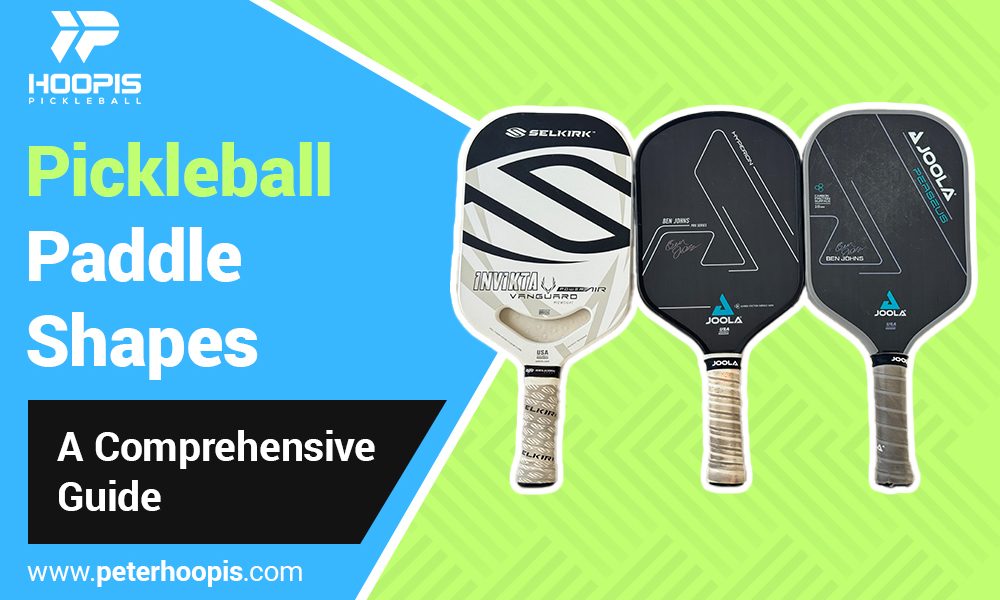It seems that pickleball is everywhere these days. If you have played, you probably know why.
This sport is a ton of fun, its competitive, and has a great social aspect to it. And the more you get into the game, the more you realize just how much “stuff” there is!
Pickleball paddles are no exception. More and more companies are entering the scene and there is newer technology to help make better paddles. The market is changing and evolving at a rapid pace.
Figuring out what type of pickleball paddle to get can be a challenge and confusing. There are so many different pickleball paddle shapes, sizes, and materials it can be hard to choose.
In this blog post, we hope to help you in your pickleball paddle buying process by giving you the ultimate guide to pickleball paddle shapes.
We’ll take a look at all of the pickleball paddle shapes, materials, and features to help you make an informed decision and find your ideal paddle shape.
Let’s get started!
- Understanding paddle shapes can help you choose the best one for your playing style.
- Consider factors such as grip size, weight and material when selecting a paddle shape.
- Experiment with different pickleball paddles to find the perfect fit for your performance and comfort level.
What Are The Different Pickleball Paddle Shapes?
Pickleball paddles come in different pickleball paddle shapes, each with its own set of benefits and drawbacks. The four main paddle shapes are:
- Classic
- Widebody
- Elongated
- Blade
Understanding these paddle shapes will help you determine which one suits your playing style and preferences the best so you can find the right paddle.
Classic Shape
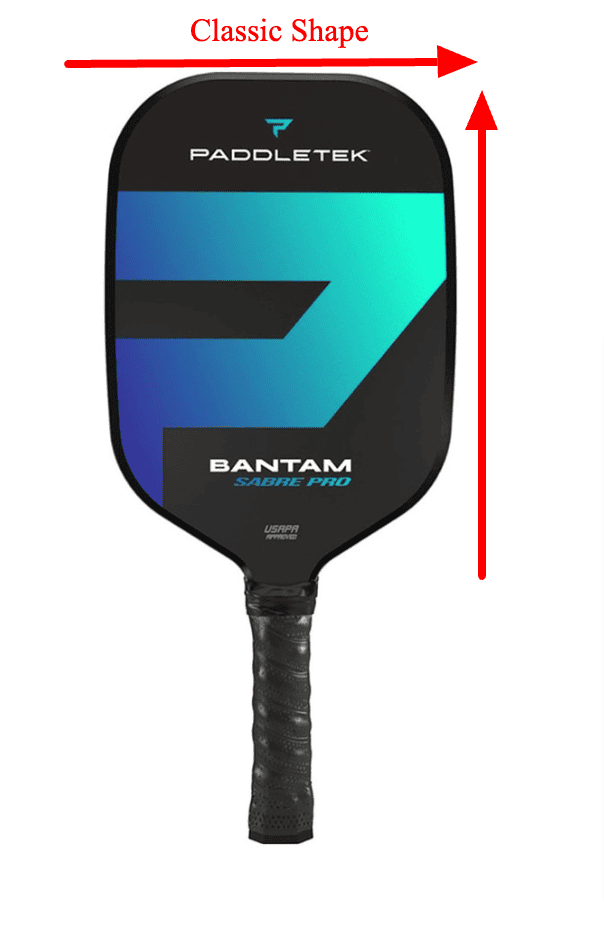
The classic shape (standard shaped paddles) is the original rectangular paddle, measuring approximately 16 to 17 inches in length and 7 to 8 inches in width. This traditional design is popular among both beginner and intermediate players due to its balanced performance. The classic shape offers a good combination of flexibility, spin, and power, making it a versatile paddle for various playing styles.
If you prefer control over power and appreciate the balance between flexibility and spin, the classic shape might be the perfect paddle for you. It’s an excellent all-rounder, suitable for players who want a well-rounded performance from their paddle.
Widebody Pickleball Paddles
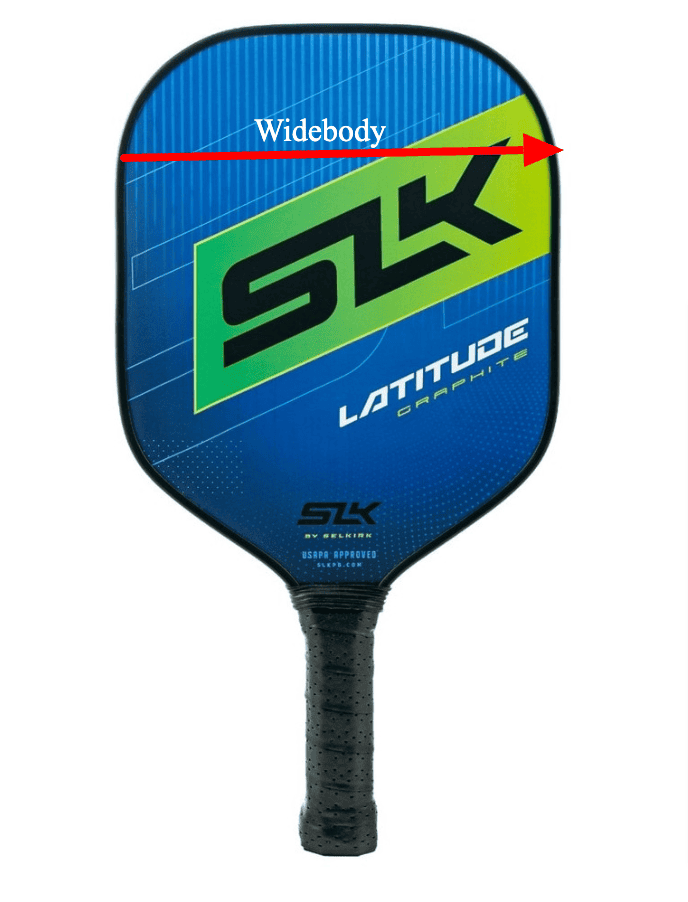
The widebody shape stands out with its wider face, measuring approximately 8.5 inches in width, and a shorter length of around 15.5 inches. This design provides a larger sweet spot and improved flexibility compared to other shapes, making it ideal for players who value precision and control or are new to the game. The wider face allows for more stability and increased sweet spot size, enabling you to hit those crucial shots with confidence.
However, widebody pickleball paddles may not be the best choice for players who prioritize reach and power, as its shorter length limits these attributes. Despite this, the widebody shape remains a popular choice for those focusing on accuracy, speed, and adaptability during gameplay.
Elongated Pickleball Paddles
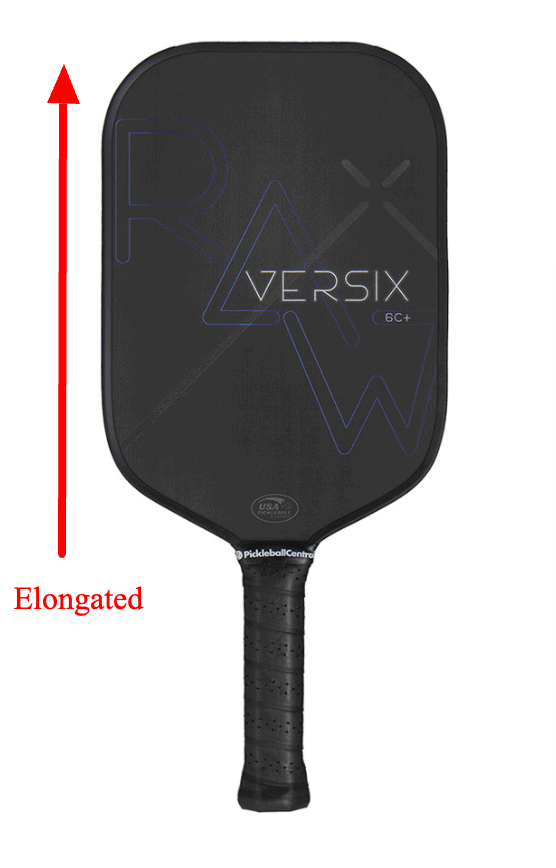
The elongated paddle shape is characterized by its greater length, providing additional weight balance at the “top” of the paddle. The elongated paddle offers more power and reach compared to other shapes. However, the elongated paddle shape sacrifices some flexibility and has a smaller sweet spot, which may make controlling softer shots more challenging.
Elongated pickleball paddles are an excellent choice for players transitioning from tennis or racquetball, as the extended length provides a familiar feel. Additionally, tournament players can rest assured that most elongated pickleball paddles are approved for play, as long as they adhere to tournament regulations.
If power and reach are your priorities, the elongated paddle shape might be the perfect fit for you.
Blade Shape
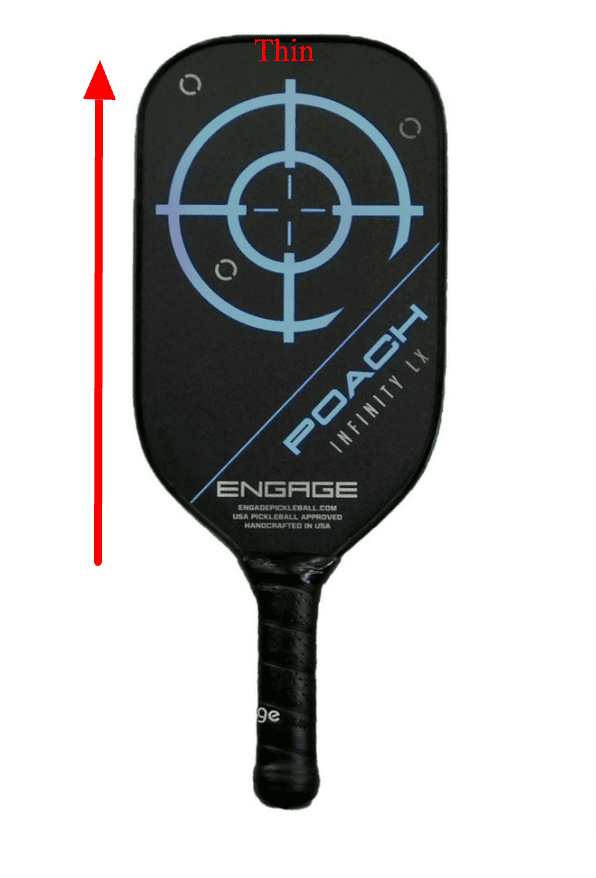
The blade shape paddle in pickleball:
- Measures 17 inches in length and has a maximum width of 7 inches
- Is favored by singles players for its longer reach and generous sweet spot
- Has a reduced center sweet spot compared to other shapes, making it more challenging to control
If you’re a singles player seeking a paddle that enhances your all-court play, the blade shape may be the perfect choice for you. With its unique design and length, the blade shape allows you to cover more of the court and hit powerful shots while maintaining control.
Material Choices and Their Impact on Paddle Shape
In addition to the shape, the material of a pickleball paddle significantly impacts its performance, weight, and price. The three primary materials utilized for pickleball paddles are composite, wood, and graphite, each with its own set of advantages and drawbacks. Understanding these materials and their influence on paddle shape will help you further refine your search for the perfect paddle.
Let’s explore these material choices and how they affect the paddle’s shape, performance, and suitability for different skill levels.
Composite Paddles
Composite paddles, including polymer core paddles, are made from a combination of materials, such as fiberglass, carbon fiber, and other mesh and molding materials. These versatile paddles provide a balance between power and control, making them a popular choice among players of various skill levels. Generally, composite paddles are heavier than other materials, ensuring consistency with each swing. However, thinner polymer core paddles offer a lighter alternative without compromising performance.
While composite paddles come at a mid-range price, they offer a variety of sizes and weights to cater to different player preferences. If you’re looking for a versatile paddle that provides a balance between power and control, composite paddles may be the right choice for you.
Wood Paddles
Wood paddles are a budget-friendly option that offers durability and affordability in comparison to other materials. Although wood paddles are generally heavier, they can still provide a solid performance for novice players or those who prefer a heavier paddle. However, the heavier weight can impact maneuverability and control, which may be a drawback for some players who might opt for lighter paddles instead.
Despite their lower price point, wood paddles can still be a viable option for those looking for a durable and economical choice. If you’re new to pickleball or simply prefer a heavier paddle, wood paddles might be the right choice for you.
Graphite Paddles
Graphite paddles are made from a type of carbon fiber, known for their strength, lightness, and power. These characteristics make graphite paddles a popular choice among advanced and professional players. Graphite paddles are lightweight and still have power and good control.
Although graphite paddles are the most expensive option, their lightweight, strong, and powerful features make them an excellent choice for players seeking to elevate their game. If you’re an advanced or professional player looking for a high-quality paddle, graphite paddles may be the perfect fit for you.
Edgeless vs. Edged Pickleball Paddles
Another factor to consider when choosing a pickleball paddle is whether to opt for an edgeless or edged paddle. Edgeless paddles do not feature edge guards, making them lighter and more maneuverable than edged paddles. However, edged paddles provide extra protection and durability, preventing damage to the paddle’s edges during gameplay.
Let’s compare the benefits of edgeless and edged paddles to help you decide which type is more suitable for your needs.
Benefits of Edgeless Paddles
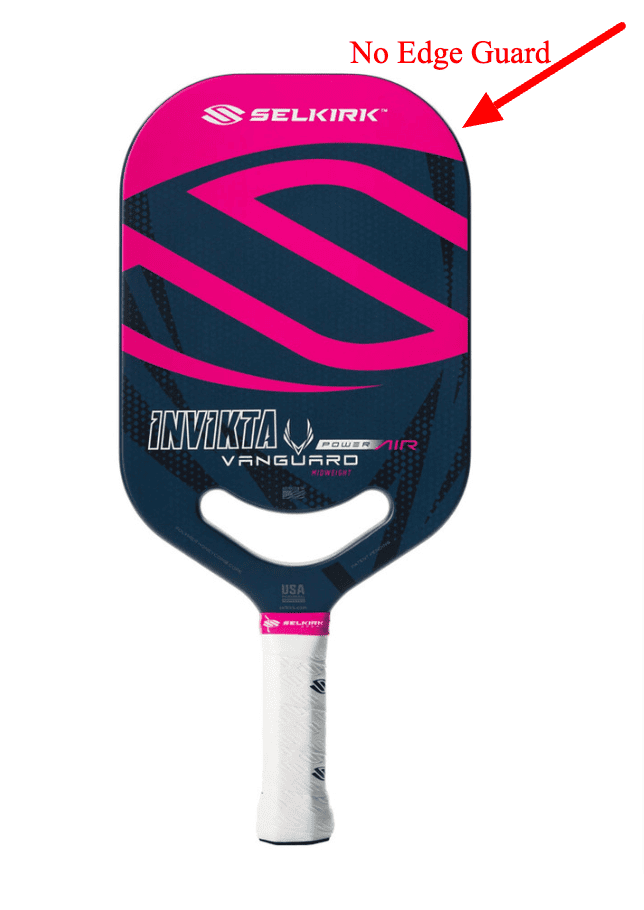
Edgeless paddles offer the following benefits:
- Larger sweet spot for greater precision and control when striking the ball
- More freedom for a wider range of shot choices and greater creativity during gameplay
- Better control for more accurate ball placement and more precise shots
These features make edgeless pickleball paddles ideal for accuracy, speed, and flexibility in table tennis.
If you prioritize accuracy, speed, and adaptability in your gameplay, an edgeless paddle might be the perfect choice for you. With its larger sweet spot and improved control, an edgeless paddle can help you elevate your game and outsmart your opponents.
Benefits of Edged Paddles
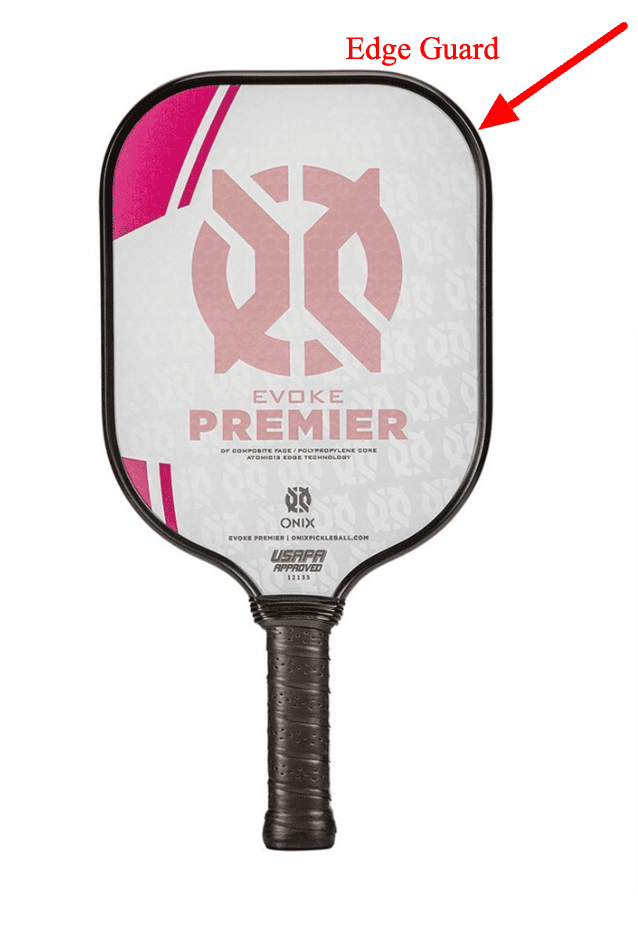
Edged paddles come with edge guards that provide extra protection and durability, preventing damage to the paddle’s edges during gameplay. This additional safeguarding helps maintain the integrity of the paddle core materials, ensuring that your paddle remains in top condition for longer. While edged paddles may be slightly heavier than edgeless versions, the added protection can be a worthwhile trade-off for players who value durability.
If you prioritize durability and protection in your paddle choice, an edged paddle might be the perfect fit for you. With its enhanced safeguarding against scratches and damages, an edged paddle can give you peace of mind and confidence in your game.
Need a pickleball paddle set? We’ve got you covered with our list of the best pickleball paddle sets under $100.
How to Choose the Perfect Pickleball Paddle Shape for You
With so many shapes, materials, and features to consider, choosing the perfect pickleball paddle can seem like a daunting task. To make this decision easier, it’s essential to assess your gameplay, try different paddle shapes, and consider factors like grip size, handle length, weight, and material. By doing so, you’ll be able to find a paddle that not only feels comfortable in your hand but also enhances your gameplay and maximizes your potential on the court.
Let’s dive into the process of selecting the perfect pickleball paddle shape for you, starting with assessing your gameplay and trying different paddle shapes.
Assessing Your Gameplay
To choose the most suitable paddle shape, it’s important to evaluate your playing style, strengths, and weaknesses. By assessing your playing style, you can better understand which paddle shape will complement and enhance your skills on the court.
For example, if you have a powerful playing style, an elongated paddle might be more suitable for you, while a player who values control might prefer a classic or widebody shaped paddle.
By identifying your strengths and weaknesses, you can make an informed decision on which paddle shape will best support your growth and development in pickleball.
Trying Different Paddle Shapes
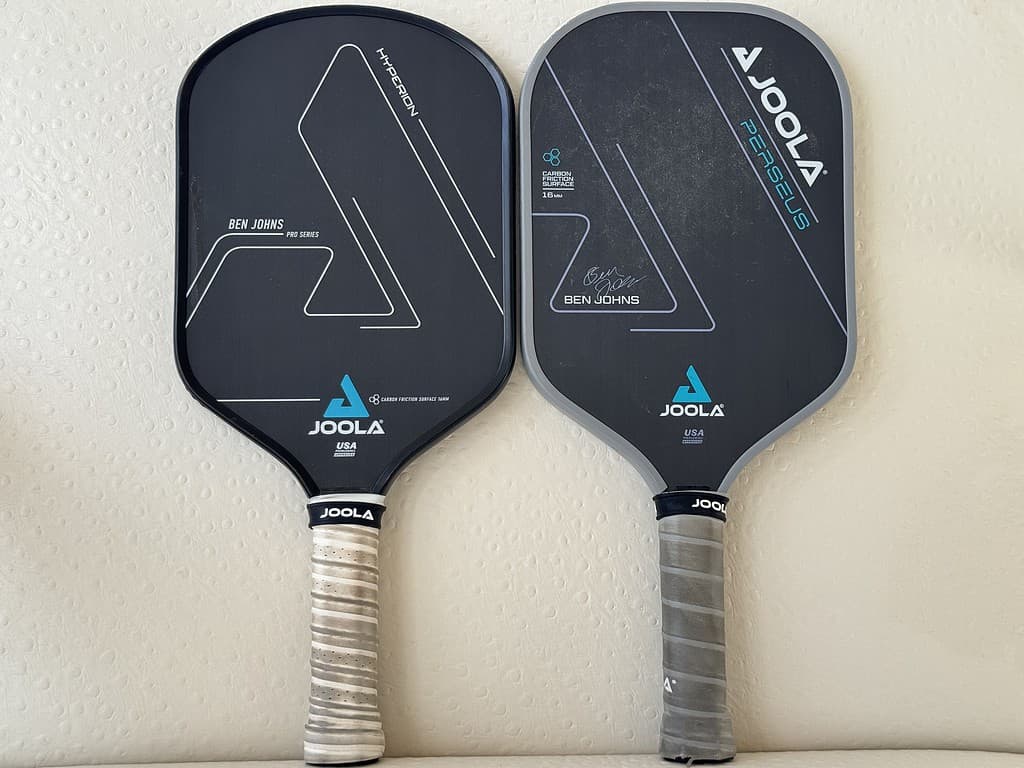
One of the best ways to determine which paddle shape suits you best is to try different shapes and see how they feel in your hand and how they affect your gameplay. By experimenting with various paddle shapes, you can gain firsthand experience on how each shape impacts your performance on the court, allowing you to make a more informed decision.
Don’t be afraid to try out different shapes and ask fellow players for their opinions and experiences with different paddles. With some trial and error, you’ll be able to find the paddle shape that feels most comfortable and enhances your gameplay, setting you up for success in the world of pickleball.
Popular Pickleball Paddle Brands and Their Shape Offerings
Several popular pickleball paddle brands offer a variety of shapes to cater to different player preferences. Some of these brands include:
These brands provide a wide range of paddles in various shapes, materials, and price points.
By exploring these brands and their offerings, you can find the right pickleball paddle that meets your needs and helps you excel on the court.
Summary
In conclusion, choosing the perfect pickleball paddle shape involves understanding the different shapes, materials, and features available, as well as assessing your gameplay and trying various paddle shapes. By considering factors like grip size, weight, sweet spot and material, you can find a paddle that not only feels comfortable but also enhances your performance on the court.
Whether you’re a beginner, intermediate, or advanced player, investing time and effort in selecting the right pickleball paddle will undoubtedly pay off in the long run, allowing you to enjoy this exciting sport to the fullest.
Frequently Asked Questions
Get answers to a list of the most Frequently Asked Questions.
To decide on the best pickleball paddle to use, consider the handle and grip length; a longer handle length works best for two-handed backhands or larger hands. Most pickleball grip sizes range from 4”-4.25”. Additionally, pick wooden paddles for entry-level players while composite or graphite paddles offer more power and control.
Yes, there is indeed a difference between pickleball paddles, with various tangible and intangible factors playing a role in their quality and performance.
A wide body pickleball paddle is typically 8’’ or greater in width and 15 34” in length, making it a great option for novice players as it gives them room for error when swinging the paddle.
This extra width and length allows for a larger sweet spot, which is the area of the paddle that produces the most power and accuracy when striking the ball. It also provides more control and stability when hitting the ball, making it easier for novice players to learn the game.
The four primary paddle shapes are classic, widebody, elongated, and blade.
The material of a pickleball paddle affects its weight, price and overall performance, making it an important factor to consider when purchasing.

